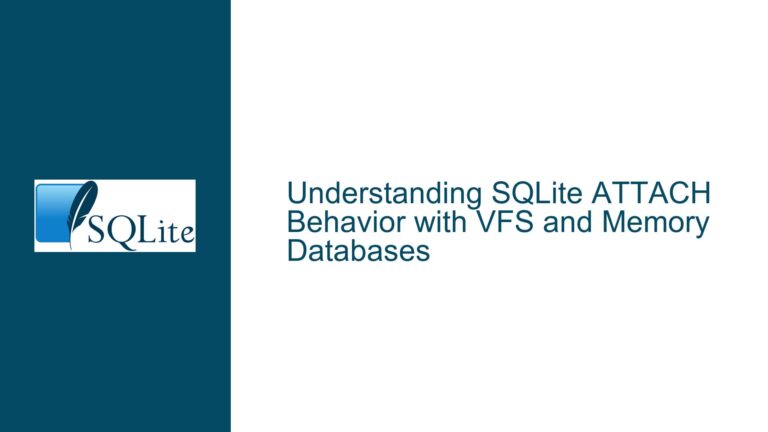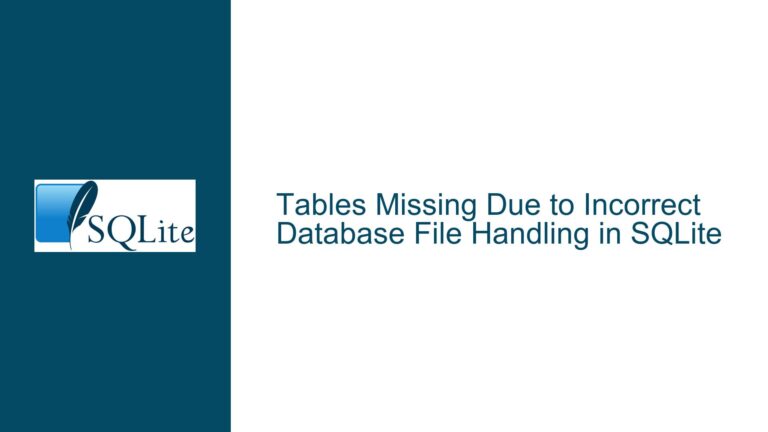SQLite JSON Functions and Property Order Preservation
Understanding JSON Property Order in SQLite
The issue of whether SQLite’s JSON functions preserve the order of properties within JSON objects is a nuanced topic that touches on both the technical implementation of SQLite and the broader specifications of JSON itself. JSON, or JavaScript Object Notation, is a lightweight data interchange format that is easy for humans to read and write, and easy for machines to parse and generate. However, the JSON specification explicitly states that an object is an unordered set of name/value pairs. This means that, according to the JSON standard, the order of properties within a JSON object should not be relied upon.
In SQLite, the JSON functions provided by the json1 extension allow users to manipulate JSON data directly within the database. These functions include json_replace, json_set, json_insert, and others, which can be used to modify JSON strings. The question at hand is whether these functions preserve the order of properties within JSON objects when they are modified or created.
The current implementation of SQLite’s JSON functions does, by chance, preserve the order of properties within JSON objects. However, this behavior is not guaranteed by the SQLite documentation, and the developers have explicitly stated that this is not a feature that should be relied upon. In fact, the developers have indicated that this behavior may change in future versions of SQLite, as it is not in line with the JSON specification.
Why JSON Property Order Preservation is Problematic
The JSON specification’s stance on property order is rooted in the idea that JSON objects should be treated as unordered collections of key-value pairs. This design choice was made to simplify the parsing and generation of JSON data, as well as to ensure interoperability between different systems and programming languages. If JSON objects were required to preserve property order, it would complicate the implementation of JSON parsers and generators, and could lead to inconsistencies between different implementations.
In the context of SQLite, the decision to not guarantee property order preservation is consistent with the JSON specification. SQLite’s JSON functions are designed to be lightweight and efficient, and adding guarantees about property order would add unnecessary complexity to the implementation. Furthermore, relying on property order preservation could lead to subtle bugs and compatibility issues, especially if the behavior changes in future versions of SQLite.
It’s also worth noting that while some programming languages, such as JavaScript, have started to preserve the order of properties within objects, this behavior is not universal. In JavaScript, the order of properties is only guaranteed for non-integer keys, and even then, the behavior can vary between different JavaScript engines. This further underscores the importance of not relying on property order preservation in JSON data.
How to Handle JSON Property Order in SQLite
Given that SQLite’s JSON functions do not guarantee property order preservation, it’s important to design your database schema and queries in a way that does not rely on this behavior. Here are some strategies for handling JSON property order in SQLite:
Avoid Relying on Property Order: The most straightforward approach is to simply avoid relying on the order of properties within JSON objects. Instead, treat JSON objects as unordered collections of key-value pairs, and design your queries and application logic accordingly. This approach is consistent with the JSON specification and ensures that your code will work correctly regardless of how SQLite’s JSON functions are implemented.
Use Arrays for Ordered Data: If you need to preserve the order of elements, consider using JSON arrays instead of objects. JSON arrays are ordered collections of values, and their order is guaranteed to be preserved. For example, instead of storing data as
{ "foo": 42, "bar": 10, "baz": 20 }, you could store it as[ {"name": "foo", "value": 42}, {"name": "bar", "value": 10}, {"name": "baz", "value": 20} ]. This approach allows you to preserve the order of elements while still using JSON data.Normalize Your Data: In some cases, it may be more appropriate to normalize your data and store it in separate tables rather than using JSON. For example, instead of storing a JSON object with multiple properties, you could store each property as a separate row in a table. This approach eliminates the need to worry about property order and can also improve query performance and data integrity.
Use Custom Sorting Logic: If you absolutely need to preserve the order of properties within JSON objects, you can implement custom sorting logic in your application code. For example, you could store the desired order of properties in a separate field or table, and then use that information to sort the properties when retrieving the data. This approach adds complexity to your application, but it allows you to control the order of properties without relying on SQLite’s JSON functions.
Monitor SQLite Updates: Since the behavior of SQLite’s JSON functions may change in future versions, it’s important to stay informed about updates to the SQLite library. If you are relying on the current behavior of the JSON functions, you should monitor the SQLite release notes and be prepared to update your code if the behavior changes. This is especially important if you are using SQLite in a production environment where changes to the JSON functions could impact your application.
Consider Alternative Databases: If preserving the order of properties within JSON objects is a critical requirement for your application, you may want to consider using a different database that provides stronger guarantees about JSON property order. For example, some NoSQL databases, such as MongoDB, allow you to store and query JSON data with more control over property order. However, this approach comes with its own set of trade-offs, and you should carefully evaluate whether it is the right choice for your application.
Conclusion
The issue of JSON property order preservation in SQLite is a complex one that requires careful consideration of both the JSON specification and the implementation details of SQLite’s JSON functions. While the current implementation of SQLite’s JSON functions does preserve the order of properties within JSON objects, this behavior is not guaranteed and may change in future versions. As a result, it’s important to design your database schema and queries in a way that does not rely on property order preservation.
By avoiding reliance on property order, using arrays for ordered data, normalizing your data, implementing custom sorting logic, monitoring SQLite updates, and considering alternative databases, you can ensure that your application remains robust and maintainable in the face of potential changes to SQLite’s JSON functions. Ultimately, the key to handling JSON property order in SQLite is to adhere to the principles of the JSON specification and to design your application with flexibility and future-proofing in mind.






